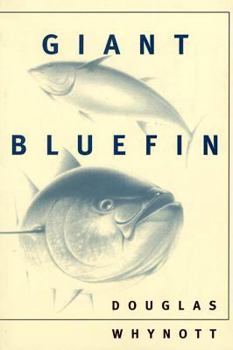Giant Bluefin
Select Format
Select Condition 
Book Overview
This elegantly written and compelling work portrays the way the Japanese demand for giant bluefin tuna has altered the lives of Cape Cod fishermen.
In telling the story of one man's passionate hunt for giant bluefin, Douglas Whynott's Giant Bluefin details the competition and camaraderie in the bluefin fishery, the pressures of a conservationist movement seeking to limit the bluefin harvest, and the struggle of the fisherman...
Format:Paperback
Language:English
ISBN:0865474974
ISBN13:9780865474970
Release Date:June 1996
Publisher:Farrar, Strauss & Giroux-3pl
Length:242 Pages
Weight:0.70 lbs.
Dimensions:0.7" x 5.5" x 8.2"
Related Subjects
Agricultural Sciences Animals Biographies Conservation Engineering Field Guides Fish Fish & Sharks Fishing Hospitality, Travel & Tourism Hunting & Fishing Industries & Professions Nature Nature & Ecology Professionals & Academics Science & Math Sports & Outdoors Sports & Recreation TechnologyCustomer Reviews
5 ratings
Great transaction!
Published by Thriftbooks.com User , 16 years ago
This seller was very fast in shipping me my purchase and the book arrived in great shape...I would definitely buy from this person again!
a fine read
Published by Thriftbooks.com User , 17 years ago
so well-written and in-depth coverage of a dying and classic method of fishing for the richest fish in the sea.
riveting book about tuna and the harpoon fishery
Published by Thriftbooks.com User , 20 years ago
I thoroughly enjoyed this book and found it surprisingly engrossing. It introduced me to a whole other world, the world of commercial fishing, one I knew little about, a world filled with rivalries, friendships, a long history, a world I think most Americans don't appreciate. Though focusing primarily on the harpoon fishery of the giant bluefin tuna or "jumbo bluefin" (known by the scientific name of _Thunnus thynnus_) of New England waters, the author Douglas Whynott discusses fishermen who use other methods (such as trolling or using a purse seine) as well as problems that the fishing industry and that individual fishermen face in general as well as some topics in marine biology. The giant bluefin fishery is a lucrative market, with individual fish often worth $40 or more a pound (when fat after having feed all season on local prey fish), some fish bringing in at market prices as high as $50,000 per fish (though often much lower than that). The highest prices are obtained in Japan, where red tuna meat (maguro) is highly prized. Individual fish are packed in ice and air-lifted over to Japan, each specimen analyzed there at market in a method not unlike a raw diamond is regarded by professional jewelers so that the best cuts could be made, all so Japanese restaurant goers can pay upwards of $75 for a single serving of raw fish. Whynott relates how the bluefin tuna fishery has come a long way; the bluefin was once called the "horse mackerel" and worth a mere five cents a pound, generally being served as cat food. In fact in the early 20th century they were even thought to be poisonous and were primarily caught so that the fish could be boiled to produce lamp oil. Fishermen who specialized in bluefin have often had to get other jobs when the fishing season was over, whether fishing for cod or other fish, shrimping, harvesting mussels, or even working non-fishing jobs, something that has been slowly changing as the market for bluefin has become more lucrative though not still quite prevalent. The fish obtained for the sushi market are provided by the harpoon fishery of New England, an industry that while using spotter planes to locate schools, sophisticated devices to measure water temperature, and a knowledge of esoteric regulations in international committees and national organizations that govern quota size for each season's catches (regulations that are often the subject of intense debate, a topic well-covered in the book), Japanese market preferences (to properly grade fish often takes year of experience, as each fish taken to market is graded on freshness, color, fat, and shape), and even currency fluctuations (as upward or downward exchange rates of the yen versus the dollar can mean large differences in prices received), still relies on a single man hand-throwing a bronze-headed harpoon at a fast moving fish (albeit a harpoon rigged so that a powerful 800-volt electric shock can be delivered to the animal). No other method will do, as pur
Gets It Right
Published by Thriftbooks.com User , 24 years ago
I have bought this book for several of my friends. Whynott gets it right, this fishery. This is a kind of source book for it, and a history of the people who do it. The review below by the smartass reviewer (what's this see-me stuff anyway?) says that "A Perfect Storm" is a better book, and it is in a way. That's a great adventure book, but in my estimation, you'll learn more about fish and fishermen, and the people in this whacky fishery, by reading Giant Bluefin. It's one of the best books I've read about fishing.
Greatly informative & entertaining read!
Published by Thriftbooks.com User , 25 years ago
What an eye opener! People still pursuing giants with harpoons! A very well written & thoroughly informative book, with some great action included! I never knew people still "scratched" out a living this way! I recommend to any avid fisherman!





